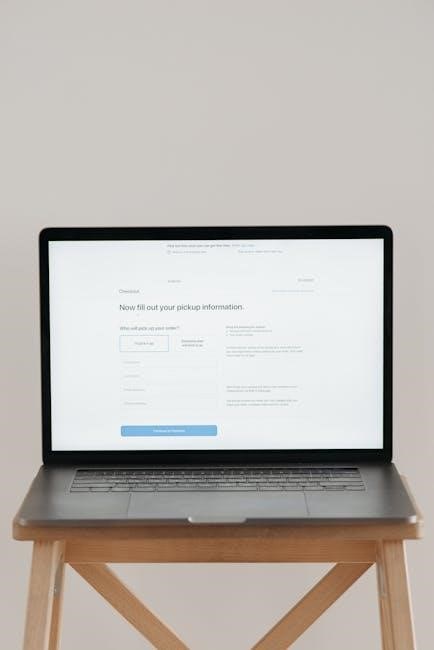OREA Rental Application Form 410 PDF Download: An Overview
The OREA Rental Application Form 410 is a standardized document used in Ontario‚ Canada. It helps landlords gather necessary information from potential tenants. This form is crucial for tenant screening and decision-making. Download the PDF to begin the process.
What is the OREA Form 410?
The OREA Form 410‚ officially known as the Rental Application Residential‚ is a standardized document created by the Ontario Real Estate Association (OREA). It is widely used by landlords in Ontario to collect relevant information from prospective tenants. This form serves as a comprehensive tool to assist landlords in evaluating potential renters.
Form 410 gathers crucial details such as the applicant’s name‚ date of birth‚ contact information‚ employment history‚ rental history‚ and references. It also includes a consent section where applicants authorize landlords to collect and verify their personal information. Landlords use this data to assess the applicant’s suitability and make informed decisions about renting their property.
It’s important to note that OREA bears no liability for the use of this form. The form is designed to be used and reproduced by OREA members and licensees only‚ with any other use prohibited without prior written consent from OREA.

Purpose of the OREA Form 410
The primary purpose of the OREA Form 410 is to provide landlords in Ontario with a standardized method for gathering essential information from potential tenants. By using this form‚ landlords can efficiently collect consistent data from all applicants‚ streamlining the tenant screening process. This ensures that landlords have a comprehensive overview of each applicant’s background and qualifications.
The form allows landlords to assess an applicant’s financial stability through employment details and rental history. References provided in the form enable landlords to verify the applicant’s past behavior as a tenant. Furthermore‚ the consent section ensures that landlords have the legal authorization to conduct necessary background checks and verify information.
Ultimately‚ the OREA Form 410 aims to facilitate informed decision-making for landlords‚ helping them select reliable tenants and minimize potential risks associated with renting their properties. It ensures a fair and transparent process for both landlords and prospective tenants in the Ontario rental market.

Key Elements of the OREA Form 410
The OREA Form 410 includes sections for applicant information‚ employment details‚ rental history‚ references‚ and consent. These elements ensure landlords gather comprehensive data for informed tenant selection in Ontario.
Applicant Information Section
The Applicant Information Section of the OREA Form 410 is designed to collect essential personal details from prospective tenants. This section typically requires the applicant to provide their full legal name‚ date of birth‚ and current contact information‚ including phone number and email address. Landlords use this information to verify the applicant’s identity and to communicate with them throughout the rental application process. Accurate and complete information in this section is crucial for the application to be considered valid.
Additionally‚ the applicant may be asked to provide alternative contact information‚ such as that of a close relative or friend‚ for emergency purposes. Landlords use this data to perform background checks and assess the applicant’s suitability as a tenant. All data provided must be truthful and up-to-date to avoid potential complications during the screening process. This section sets the foundation for the landlord’s initial assessment of the applicant.
Employment Details Section
The Employment Details Section of the OREA Form 410 is a critical component for landlords assessing a prospective tenant’s financial stability. This section requires applicants to provide comprehensive information about their current and‚ in some cases‚ previous employment. Typically‚ applicants must list their employer’s name‚ address‚ and contact information‚ along with their job title and duration of employment.
Furthermore‚ the form usually asks for details regarding the applicant’s income‚ including salary or hourly wage. Landlords use this information to determine if the applicant has sufficient income to cover the monthly rent and other living expenses; Providing accurate and verifiable employment details is essential‚ as landlords may contact employers to confirm the information provided. Self-employed individuals might need to submit additional documentation‚ such as tax returns or bank statements‚ to substantiate their income. A complete and honest employment history significantly strengthens a rental application.
Rental History and References Section
The Rental History and References Section of the OREA Form 410 is designed to give landlords insight into an applicant’s past tenancy behavior. This section requires prospective tenants to provide information about their previous rental accommodations‚ including addresses‚ landlords’ names‚ and contact details. Applicants typically need to list their rental history for the past few years‚ allowing landlords to assess their reliability as tenants.

Furthermore‚ the form requests personal references who can vouch for the applicant’s character and responsibility. These references should ideally be individuals who are not related to the applicant and can provide an objective assessment. Landlords often contact previous landlords and references to inquire about payment history‚ property maintenance‚ and overall conduct during the tenancy; Providing accurate and positive rental history‚ along with credible references‚ can significantly improve an applicant’s chances of securing a rental property.
Consent and Authorization Section
The Consent and Authorization Section of the OREA Form 410 is a critical component‚ granting landlords the necessary permission to verify the information provided by the applicant. By signing this section‚ the applicant consents to allow the landlord to conduct credit checks‚ contact previous landlords‚ and verify employment details. This authorization is essential for landlords to make an informed decision about the applicant’s suitability as a tenant.
This section also includes a declaration by the applicant‚ confirming that all information provided is true and accurate to the best of their knowledge. Misleading or false information can be grounds for rejection of the application or termination of a lease agreement. Furthermore‚ the consent extends to the landlord’s right to collect‚ use‚ and disclose personal information as necessary for the purpose of evaluating the rental application. It’s important for applicants to carefully read and understand this section before signing‚ as it outlines the scope of the landlord’s investigative powers.

Downloading and Filling Out the OREA Form 410 PDF
To begin‚ download the OREA Form 410 PDF from a reliable source like the official OREA website or a trusted provider. Complete each section accurately and save it as a PDF.
Finding the Official OREA Form 410 PDF
Locating the official OREA Form 410 PDF is essential for ensuring its authenticity and compliance. The primary source is the Ontario Real Estate Association (OREA) website‚ where members and licensees can access the most up-to-date version. Be cautious of third-party websites offering the form‚ as they might provide outdated or altered versions.
Always verify that the PDF you download is indeed from OREA to avoid potential issues. Look for the OREA logo and copyright information on the form itself. Additionally‚ confirm that the revision date matches the most current version available.
Using the official PDF ensures that you are adhering to the standardized format and legal requirements set forth by OREA. This reduces the risk of errors or omissions during the rental application process‚ benefiting both landlords and tenants.
Completing the Form: A Step-by-Step Guide
Filling out the OREA Form 410 accurately is crucial for a successful rental application. Begin by carefully reading each section to understand what information is required. Start with the “Applicant Information” section‚ providing your full name‚ date of birth‚ and contact details. Proceed to the “Employment Details” section‚ ensuring accuracy in listing your current and previous employment history.
Next‚ complete the “Rental History and References” section‚ including details of past residences and contact information for references. In the “Consent and Authorization” section‚ carefully review the terms before signing and dating the form. Double-check all entries for errors or omissions.
Ensure all information is truthful and verifiable. Incomplete or inaccurate information can negatively impact your application. Finally‚ keep a copy of the completed form for your records before submitting it to the landlord.
Digital Completion and Saving as PDF
Completing the OREA Form 410 digitally offers convenience and efficiency. Begin by downloading the fillable PDF version of the form. Open the PDF in a compatible program like Adobe Acrobat Reader‚ which allows you to directly input information into the form fields.
As you fill out each section‚ ensure accuracy and completeness. Utilize features like digital signatures to sign the form electronically‚ if required. Double-check all entries before finalizing the document.
Once completed‚ save the filled-out form as a new PDF file to preserve the entered data. Choose a descriptive file name for easy identification. Consider creating a backup copy for your records. You can then easily share the digital PDF with landlords via email or online platforms‚ streamlining the application process. This method ensures legibility and professionalism in your submission.

Legal Considerations and OREA’s Liability
OREA bears no liability for the use of Form 410. Accurate information is vital. The form isn’t a lease agreement. Consult legal advice for specific rental situations in Ontario‚ Canada‚ for further clarification.

OREA’s Disclaimer of Liability
The Ontario Real Estate Association (OREA) explicitly states it bears no liability for your utilization of the Rental Application Residential Form 410. This disclaimer signifies that OREA is not responsible for any issues‚ damages‚ or disputes arising from using this form. Users must understand that OREA provides the form as a template‚ and its proper use‚ accuracy‚ and legal compliance rest solely on the user.

Landlords and applicants should seek independent legal advice to ensure their actions comply with Ontario’s rental laws and regulations. OREA’s disclaimer underscores the importance of users exercising their own judgment and seeking professional guidance when dealing with rental applications and agreements. OREA provides the form for its members.
Importance of Accurate Information
Providing accurate information on the OREA Rental Application Form 410 is crucial for both applicants and landlords. For applicants‚ honesty and accuracy build trust with the landlord‚ increasing the chances of securing the rental property. False or misleading information can lead to rejection of the application and potential legal consequences if discovered later.

Landlords rely on the information provided to assess the applicant’s suitability as a tenant‚ including their financial stability‚ rental history‚ and personal references. Inaccurate information can lead to poor tenant selection‚ resulting in property damage‚ unpaid rent‚ or legal disputes. Landlords have the right to verify the information provided and take appropriate action if discrepancies are found. Ensuring accuracy protects both parties.

Updates and Revisions to Form 410
OREA regularly updates its forms‚ including Form 410‚ to reflect current regulations and best practices. Always check for the most recent version before using the form to ensure compliance and accuracy.
2025 Updates to OREA Forms
The Ontario Real Estate Association (OREA) has implemented updates to its rental application forms for 2025‚ including significant revisions to Forms 410‚ 400‚ and 100. These updates are crucial for maintaining compliance with current regulations and streamlining the rental process for both landlords and tenants in Ontario. Landlords and property managers should familiarize themselves with these changes to ensure they are using the most up-to-date versions of the forms.
The updated forms reflect adjustments to legal requirements and industry best practices‚ providing a more comprehensive and legally sound framework for tenant screening and application processes. These revisions are essential for all OREA members and licensees to adhere to. Using the most current version ensures accuracy and protects against potential legal issues that may arise from using outdated forms. It is important to download the latest versions from the official OREA website or authorized sources.
Checking for the Most Current Version
To ensure you are using the most up-to-date OREA Rental Application Form 410‚ it is essential to regularly check the official OREA website or authorized sources. OREA periodically updates its forms to reflect changes in legislation and best practices within the Ontario rental market. Using an outdated form can lead to inaccuracies or non-compliance‚ potentially causing legal issues.
Always verify the revision date on the form against the latest version available from OREA. Members and licensees should prioritize accessing forms directly from OREA to guarantee authenticity and currency. Third-party websites may not always offer the most recent version‚ so relying on official sources is crucial. Regularly checking for updates will help maintain accurate and legally compliant rental processes. Keep an eye out for any announcements or notifications from OREA regarding form revisions.
